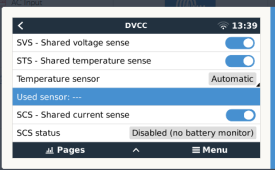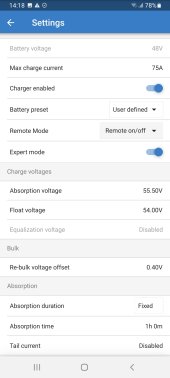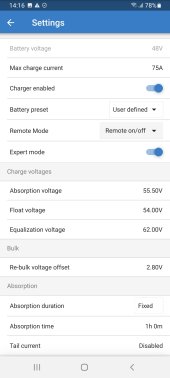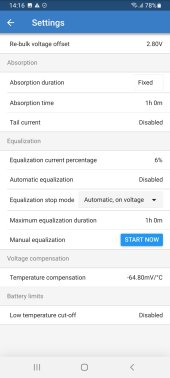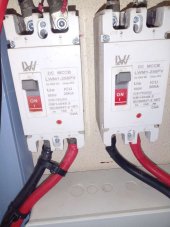I have a Quattro 48/15000/200-100/100 Inverter; two SmartSolar MPPT RS 450|100 Charge Controllers and Cerbo GX which I was using with a Wakatek 48V 300AH LFP battery pack which does not have any communication cable. I have DVCC enabled with max charge voltage 55.8V / max charge current 75A per Wakatek supplier requirement. For each charge controller, VictronConnect was also used to set absorption voltage / float voltage /max charge current at 55.8V/55.5V/75A. VEConfigure was also used to make the same settings on the Quattro. Worked fine.
Now I have just added two parallel Felicitysolar 48V 200AH battery packs model numer LPBF48200-N in parallel to the existing Wakatek 48V 300AH battery pack. The installer has changed the DVCC settings to max charge voltage 55.8V / max charge current 136A. Based on my current solar panels capacity (6.55KW of CanadianSolar panels) I can't generate more than about 136A. (I will soon add another 3.3KW of solar panels). But the Felicitysolar battery pack datasheet calls for 57.6V absorption and 57.6V float settings.
My questions:
1. Are these settings correct / optimal?
2. Does the charge controller setting in VictronConnect for max charge current apply to each charge controller or to the batteries on the DC busbar? For example, if each of the two charge controllers is set at max charge current of 75A, does that represent a max charge current of 150A to the batteries or still a max charge current of 75A to the batteries on the busbar? Just want to be sure.
3. Is it okay to continue to operate the Wakatek battery pack along with the Felicitysolar battery packs?
Now I have just added two parallel Felicitysolar 48V 200AH battery packs model numer LPBF48200-N in parallel to the existing Wakatek 48V 300AH battery pack. The installer has changed the DVCC settings to max charge voltage 55.8V / max charge current 136A. Based on my current solar panels capacity (6.55KW of CanadianSolar panels) I can't generate more than about 136A. (I will soon add another 3.3KW of solar panels). But the Felicitysolar battery pack datasheet calls for 57.6V absorption and 57.6V float settings.
My questions:
1. Are these settings correct / optimal?
2. Does the charge controller setting in VictronConnect for max charge current apply to each charge controller or to the batteries on the DC busbar? For example, if each of the two charge controllers is set at max charge current of 75A, does that represent a max charge current of 150A to the batteries or still a max charge current of 75A to the batteries on the busbar? Just want to be sure.
3. Is it okay to continue to operate the Wakatek battery pack along with the Felicitysolar battery packs?



